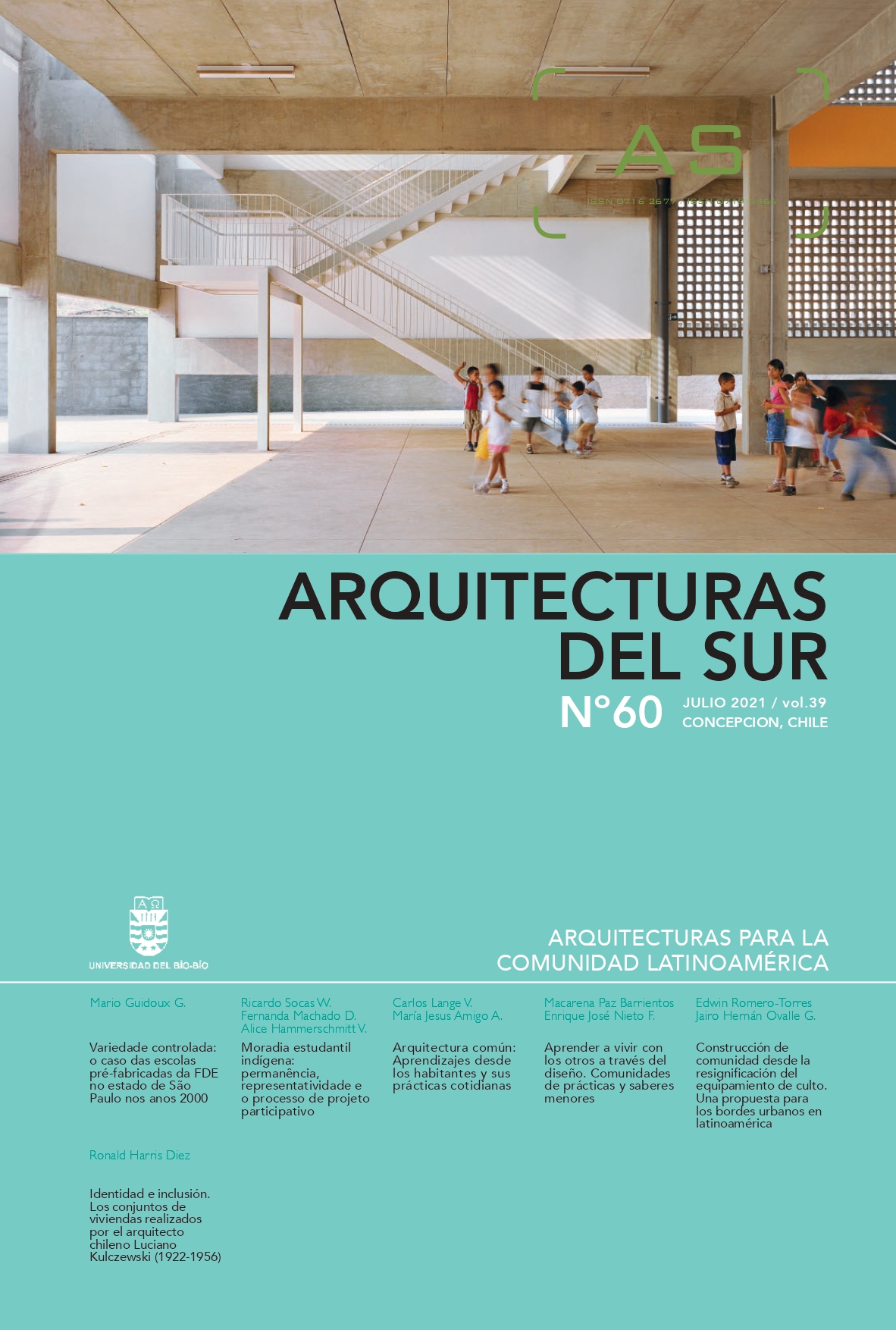Community building from the resignification of places of worship. A proposal for the urban fringes in Latin America
DOI:
https://doi.org/10.22320/07196466.2021.39.060.05Keywords:
Urban fringe, Community facilities, Urban improvement, Community participation, Flexible designAbstract
The urban fringes of Latin American cities are the result of the accelerated growth that entails the formation of new settlements, that do not meet the basic needs of their inhabitants, and where the facilities have lost their meaning as a space to build the social and urban fabric. Starting from this problem, this text addresses the development of a place of worship that incorporates the concept of device as a piece of social articulation. The proposal starts from the analysis and diagnosis of the area and proposes two intervention scales under the “option generator model” (Carvajalino-Bayona, 1985) framework. The first consists of the improvement of the neighborhood in its main urban structures, while the second consists of the development of the architectural project that integrates worship activities with the dynamics of the neighborhood, from a multifunctional perspective. In this sense, urban relationships are strengthened, but at the same time, give continuity to the reflection raised from the design, where the participatory process is an opportunity to build dialogue and social fabric between the players involved, which in this case are part of communities in conditions of vulnerability.
Downloads
References
ALCALDÍA MUNICIPAL DE SOACHA (2018). Plan de Ordenamiento Territorial del Municipio de Soacha. Recuperado de http://alcaldiasoacha.gov.co/municipio/mapas/140-mapas-territoriales/86-pot-barrios
ARDILA, R. (2003). Calidad de Vida: Una definición integradora. Revista Latinoamericana de Psicología, 2(35), 161-164. Recuperado de https://www.redalyc.org/pdf/805/80535203.pdf.
CARVAJALINO-BAYONA, H. (1985). Arquitectura y comunidad: Hacia una práctica barrial de la Arquitectura. Recuperado de https://es.slideshare.net/LuisErazo2/arquitectura-comunidad-59479940
CARVAJALINO-BAYONA, H. (2019). La arquitectura en los barrios: puntos de encuentro entre la academia y el saber popular. Revista de Arquitectura (Bogotá), 21(2), 112-125. DOI: https://doi.org/10.14718/RevArq.2019.21.2.2301
DÍAZ-OSORIO, M. (2019). Arquitecturas colectivas y participación como estrategias para la construcción de la ciudad latinoamericana. Revista de Arquitectura (Bogotá), 21(2), 3-11. https://doi.org/10.14718/RevArq.2019.21.2.2670.
FRANCO CALDERÓN, A. Y ZABALA CORREDOR, S. (2012). Los equipamientos urbanos como instrumentos para la construcción de ciudad y ciudadanía. Revista Dearq, (11), 10-21.
GARCÍA FANLO, L. (2011). ¿Qué es un dispositivo?: Foucault, Deleuze, Agamben. A parte Rei Revista de Filosofía, (74), 1-8. Recuperado de http://serbal.pntic.mec.es/~cmunoz11/fanlo74.pdf
HENAO QUINTERO, L. A. (2015, junio). La permeabilidad de las formas arquitectónicas: los Mercados Municipales de Ciutat Vella y del Eixample de Barcelona. En VII Seminario Internacional de Investigación en Urbanismo, Barcelona - Montevideo. Barcelona, España. Recuperado de https://upcommons.upc.edu/bitstream/handle/2117/80279/80BCN_HenaoAdriana.pdf?sequence=1&isAllowed=y
LAITON SUÁREZ, M. (2017). Prototipos flexibles. Proyecto habitacional en el barrio popular Buenos Aires (Soacha). Revista de Arquitectura (Bogotá), 19(1), 70-85. DOI: http://dx.doi.org/10.14718/RevArq.2017.19.1.1271
MUÑOZ TORRES, G. Y GUTIÉRREZ LUNA, S. (2019). Desvanecimiento de la frontera como límite. Imaginario del borde como espacio público físico y virtual. Revista de Arquitectura (Bogotá), 21(2), 33-43. DOI: https://doi.org/10.14718/RevArq.2019.21.2.2133
OVALLE GARAY, J. Y PÁEZ CALVO, A. (2017). Equipamiento urbano en la reconstrucción de vínculos comunitarios. Arquitecturas del Sur, 51(35), 42-55. Recuperado de http://revistas.ubiobio.cl/index.php/AS/article/view/2626/2319.
PAVA GÓMEZ, A., BETANCUR VILLEGAS, M. Y PÁEZ CALVO, A. (2018). Planteamiento de una estrategia desde la construcción de una investigación proyectual. Revista de Arquitectura (Bogotá), 20(I), 88-101. DOI: https://doi.org/10.14718/RevArq.2018.20.1.1954
ROMERO TORRES, E. A. (2019). Un equipamiento de culto como dispositivo en el borde urbano de Soacha. Trabajo de Grado. Universidad Católica de Colombia. Facultad de Diseño. Programa de Arquitectura. Bogotá, Colombia.
ROSSI, A, (1966). Arquitectura de la ciudad. Barcelona: Editorial Gustavo Gili.
VEGA, G. (2017). El concepto de dispositivo en M. Foucault. Su relación con la “microfísica” y el tratamiento de la multiplicidad. Revista digital de Filosofía, (12), 136-158. Recuperado de https://revistas.unne.edu.ar/index.php/nit/article/view/2038
WEBER, H. Y PYATOCK, M. (1976). Reaprendiendo a diseñar en arquitectura (primera parte). Revista Arquitectura Autogobierno (México), (1), 4-9. Recuperado de https://fa.unam.mx/repentina/wordpress/wp-content/Newsletter/raices/RD04/revista_arquitectura/revista_01.pdf.
Downloads
Published
How to Cite
Issue
Section
License
Copyright (c) 2021 Edwin Alexander Romero-Torres, Jairo Hernán Ovalle-Garay

This work is licensed under a Creative Commons Attribution-ShareAlike 4.0 International License.
The content of the articles published in each issue of Arquitecturas del Sur is the sole responsibility of the authors and does not necessarily represent the opinion of University of the Bío-Bío.
The authors will maintain their copyright; however, they will guarantee the journal the right to first publication and dissemination of their work. The publication of the article in Arquitecturas del Sur will be subject to the Creative Commons International license (CC BY-SA) that allows others to adapt: remix, transform and build on the material for any purpose, even commercially; share: copy and redistribute the material in any medium or format, as long as the authorship and first publication in this journal are acknowledged by citing them correctly, and their new contributions are under a license with the same terms.














 Programa de Información Científica/Concurso Fondos de Publicación de Revistas Científicas 2018/ Proyecto Mejoramiento de Visibilidad de Revistas UBB (Código:FP180007)
Programa de Información Científica/Concurso Fondos de Publicación de Revistas Científicas 2018/ Proyecto Mejoramiento de Visibilidad de Revistas UBB (Código:FP180007) 
